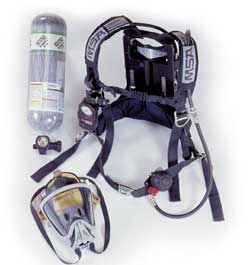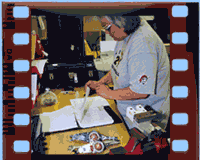You pull into
a fast food restaurant drive-in lane, seeking a quick, easy meal.
Just check the menu, speak into the microphone, and, voilá, there's
food at the pickup window! It couldn't be simpler. And best of all,
you get exactly what you want.
In the fire service marketplace, ordering SCBAs (self-contained
breathing apparatus) used to be anything but quick and easy. Each
fire department matched their preferences with a long list of options.
As SCBA were upgraded with more and more features and options, SCBA
assembly at the factory became somewhat unwieldy. Giving customers
exactly what they wanted became more difficult and time-consuming.
 Now,
with MSA's Assemble-To-Order (ATO) program, firefighters can order
the SCBAs they need in configurations that suit their requirements.
And, they can "have it their way" faster than ever. Now,
with MSA's Assemble-To-Order (ATO) program, firefighters can order
the SCBAs they need in configurations that suit their requirements.
And, they can "have it their way" faster than ever.
ATO is a production process that simplifies, yet accelerates ordering
products that have many options. Many of MSA's SCBAs and portable
instruments are now created in accordance with what is essentially
each customer's custom-written part number.
Creating and relying on ATO for all but a few part-numbered SCBA
combinations increases efficiency, cuts costs, speeds delivery,
and best of all, gives customers SCBAs that are built just the way
they want them.
How it works:
Using a simple menu that assigns a number or letter for each option,
customers select the features they want on their SCBAs. Their order
is transmitted to the shop floor at MSA's Murrysville facility.
Operators certified in SCBA assembly read the order, pull the necessary
parts from inventory, and put the systems together.
In most cases, one operator assembles an SCBA system in 30 to 45
minutes. (Previously, the same task used six to seven people.) During
SCBA assembly, operators test all sub-assemblies they build. After
all components are assembled, they test the complete system on a
breathing machine. Each system must pass all tests and evaluations
before operators can mark their approval by affixing a sticker with
their initials on the unit's harness. To confirm that the SCBA is
ready for customer use, a printout of the breathing machine results
is tucked into the shipping carton.
What this means to customers:
The average turnaround time between placing an order and shipping
that order has dropped to between less than two weeks - that's one
fourth to one eighth of the time that custom orders used to take!
And custom orders now constitute almost all SCBA orders.
"About 97% of all of our breathing apparatus are assembled to order,"
commented Joe Murray, plant manager at MSA's Murrysville plant.
"We build more than 20,000 SCBA units a year, and ATO helps us deliver
a top-quality product every time. ATO also helps us keep the cost
of SCBAs in line. The system minimizes the expenses of carrying
an extensive parts inventory. Components are manufactured as they
are needed, and new parts and technologies are quickly integrated
into the product offering -- a benefit that keeps users enjoying
the cutting edge of technology." |
|

PLACING THE RIGHT ORDER
After a customer completes an SCBA ATO order, information gathered
from the product menu is run through specialized configurator
software. The software evaluates the selections to ensure that
all components are compatible and that they meet appropriate the
appropriate agency approvals. If an unsuitable combination was
chosen, the system does not allow the order to flow to the production
floor.
Quality is built into SCBA assembly with highly skilled operators.
All complete more than 40 hours of classroom training in specialized
assembly techniques. They are re-certified annually, and their
work is routinely audited. In addition, MSA's Quality Control
staff randomly pulls SCBA units from the assembly line to check
quality and order compliance.
For more information about ATO, contact your MSA distributor or
customer service. Find out how easy it is to have SCBAs your way.
Alternatives to ATO
Stocking almost-completed or completed SCBA units in a great many
possible configurations and hoping that customers' needs will
match both the assembled products and the available quantities.
Result: huge inventories and lack of desired products.
" Creating customized orders as exceptions or "special orders"
that take weeks to make their way through the special orders process.
Result: huge delays in delivery.
|